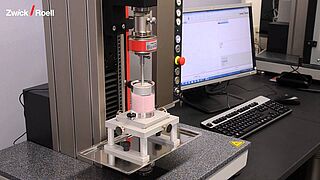Viscosity
The term viscosity describes the flow behavior of fluid systems. By moving two fluid layers against each other the fluid movements create a resistance (stiffness and internal friction), referred to as flow resistance. Viscous forces are created by moving several layers of fluid at different velocities. This causes faster flowing layers to slow down and slower flowing layers to speed up. These processes follow the laws of physics and can be defined in equations whereby shear rate (velocity gradient) and shear modulus are factors. Viscosities are always dependent on temperature. For example, viscosity measurements are performed to optimize a paste-like substance with regard to consistency or to optimally adjust it for the production line.
The back extrusion fixture as an alternative to rotation viscometers
ZwickRoell's back extrusion fixture offers an alternative solution to rotation viscometers. The principle of the back extrusion fixture is based on the displacement of the test material through an annular gap between piston and back extrusion cell. The cell is filled with the test substance and the piston is lowered into the container, pressing the material up through the annular gap. When the piston is raised, the material flows back through the annular gap into the cell.
The force is measured in the down and up cycle at a defined position. The dynamic viscosity is evaluated from the measured force difference and the flow rate of the liquid in the annular gap.
The ZwickRoell system can repeat this cycle as often as desired with freely adjustable shear rates. The test can be optimally adapted to the test material, and the viscosity can be measured across the entire shear range with one single test.
Advantages of this method
- The viscosity can be determined directly in containers from ongoing production. This rules out prestressing of the material caused by transfilling. Flow influences that occur in production plants can be reproduced by altering the annular gap and the moving speed.
- This method enables tests on masses with chunky pieces like fruit preparations and food systems: fruit pieces or other bigger ingredients are not pushed out and thus are measured together with the yogurt or the fluid.
- Individual selection of the number of test cycles and the possibility of increasing the shear rate for each of these cycles enables recording of the viscosities over the entire shear rate in just one test.
- The test results on Newtonian fluids correlate with the results from measurements with rotation viscometers. For non-Newtonian fluids reproducible, comparable test results are obtained, usually with more sensitive characteristics than those gained from rotation viscometers.
And to top it off (another advantage) testXpert III test program especially designed for viscosity testing:
This special test program includes numerous extras especially for viscosity testing. Examples: automatic preconditioning, determination of cycle numbers and speed, selection of results, etc. The test software is clearly arranged and enables comprehensive evaluation and presentation of data as well as graphical evaluation and reporting.

